Manila, Philippines – The Fashion Revolution Philippines commemorates the victims of the Rana Plaza factory collapse in Bangladesh, in alignment with the Fashion Revolution week held globally. The Rana Plaza factory collapse killed 1,138 textile workers and injured more people became an eye-opener to the world on 24 April 2013. The incident drove the Fashion Revolution movement to push for labor rights transparency and sustainability in the fashion world.
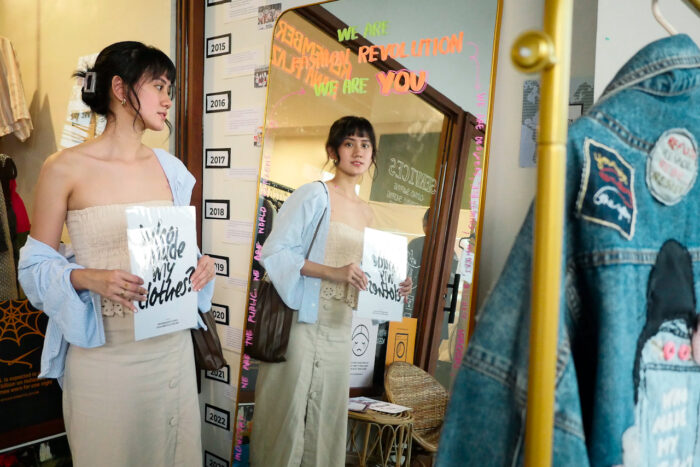
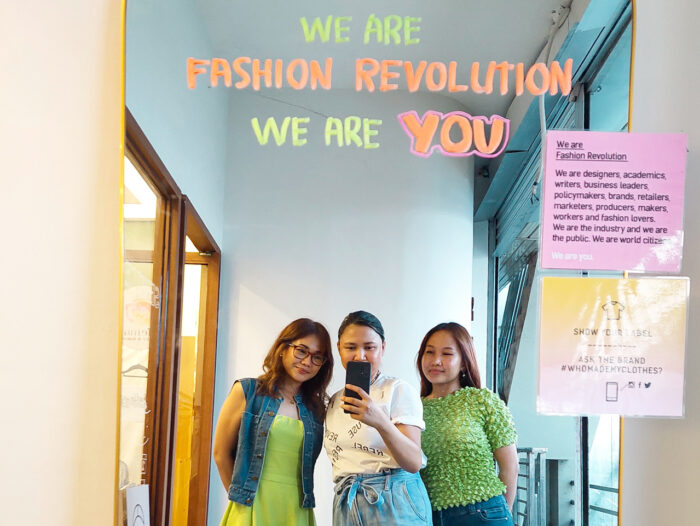
The Fashion Revolution Philippines’ first in-person event held for two days since the pandemic started. The two-day event happened in Moda Laya in commemoration of the 10 anniversary after Rana Plaza disaster. Attendees participated in activities such as clothes swapping, panel discussion with the experts and the screen showing of two documentary films.

The “Se Abrió Paca,” a film made by the Fashion Revolution Guatemala, gave a heartfelt discussion among its viewers just after it was shown with the “True Costs” documentary and the power outage on the first day. Activities on the next day went well with the clothes swapping and panel discussion. Prince Ventura leads the panel discussion with Bianca Gregorio, owner of Moda Laya and founder of Re-clothing, Irene Subang, sustainable fashion designer and educator, and Jamie Naval, founder and CEO of Twenty Kids and Barrio Studios. Our guest experts discussed that the society today needs to focus on the importance of sustainable practices and a circular wardrobe.
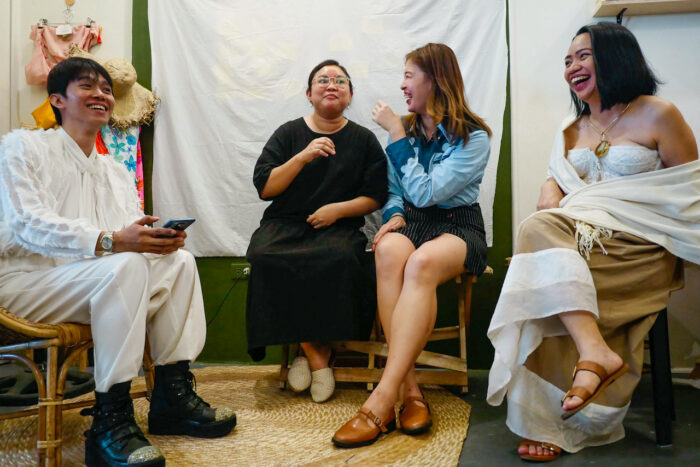
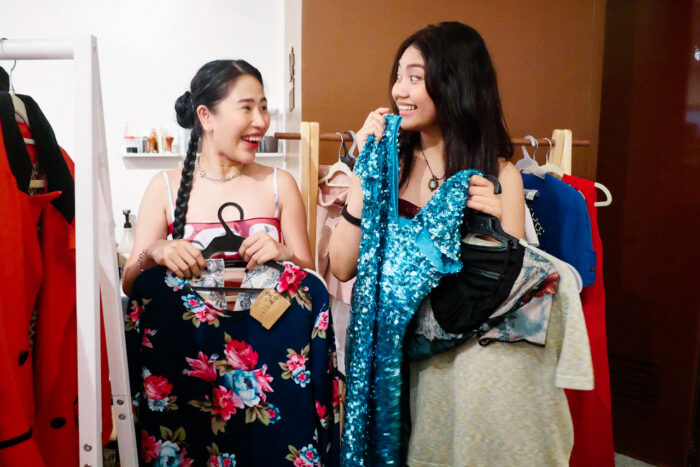
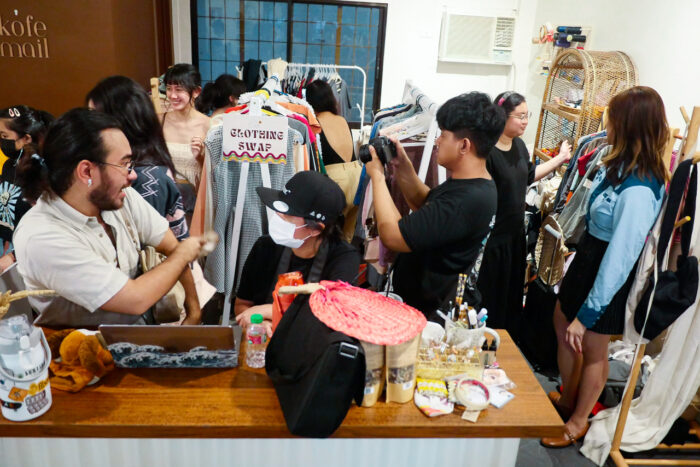
To separate her passion for natural dyeing from hand weaving, or designing from teaching, isn’t possible for Olga Reiche. All she touches is intricately woven together within her home country of Guatemala and shared far beyond. This spirited woman with a quick smile has been working with indigenous artisans on product development and marketing for over thirty years, producing her own line of naturally-dyed and recycled products, and teaching locally and internationally. Her concern for environmental and artisanal sustainability is a driving force.
Artisan to Artisan
After the devastating earthquake in 1976, Olga worked with Oxfam, an international confederation of countries working together in partnership to alleviate poverty. Olga traveled throughout the country, interviewing artisans and making recommendations for their sustainability. A decade later, she began working with women weavers in the remote Ixil Triangle, the women widowed during the violent 1980-1996 civil war. She opened a shop in Antigua (now closed), to sell their woven goods and helped the weavers with product development, but also discovered local and international markets to sell their wares.
One of the primary groups Olga now works closely with is the weaving cooperative of Ixbalem Ke, based in Samac de Cobán in Alta Verapaz, a remote area in the cloud forest. The women weave a type of intricate brocaded gauze weave, in both white on white pattern as well as natural brown cotton, and naturally dyed threads too. This Mayan weaving style was rapidly disappearing and, with Olga’s assistance, the women weavers are dedicated to preserving this traditional textile.
Learning, Teaching and Sharing
In the late 1980s, Olga met Ana Roquero who had been studying the natural dyes of Latin America and their preservation. It didn’t take long before Olga too was focused on this and over the years she researched and collected data from all over Guatemala culminating in her recent book, Dyeing Plants of Guatemala, (Spanish only), a solid resource on the use of dyes and pigments.
Olga worked with cooperatives in the Lake Atitlán area, mentoring the weavers, developing new designs and products, teaching them how to manage a business, and how to competitively market products in the international arena. In 1995, she started to teach natural dyeing techniques to artisans in this area. She returns here often, especially in the village of San Juan La Laguna where they grow and dye with local plants.
In 2008, she co-founded Artes Textiles y Populares in Antigua, an educational center which hosted programs in the textile arts for national and international groups. After the center closed, Olga ended up with some of the equipment, especially looms, so she set up a home studio. She started backstrap weaving classes complete with a manual so when you’re back home with these warped sticks and threads, you can have the continued guidance of Olga.
She also teaches natural dyeing on a small scale in her studio, growing indigo plants outside her door and working with many regionally sustainable plants. She has recently made pigments for painting by drying the plants and converting them into powder. She calls them The Natural Palette and offers classes on this as well. The next time you’re in Antigua, sign up for a class or bring your group to her studio–she’ll be more than pleased to host you.
The Upside to Recycling
Olga’s work in the field of recycling is inspiring. When Olga first started thinking about recycling, she asked herself two things: What would have a positive impact on the environment, and what would provide work for the weavers? Recycling of things that were already plentiful, too plentiful, met one of her goals. Her design aesthetic is beyond the ordinary—she’s really upcycling. Using discarded corn husks, plastic bags, cassette tapes, and jeans, she designed products that have traction in the market plus they added another line to her own organic cotton and naturally-dyed handwovens, sold under the label Indigo. Who else can mimic ikat weaving using plastic bags? And when an experienced weaver grabbed one of her jeans rag rugs at a recent ClothRoads event and bought it without hesitation, it was a thumbs-up for quality and design.
The net result has provided income to women who are the sole support of the family, allowing them to stay in their village and work. Plus the products provide work to seamstresses and leather workers. It’s a good thing.
Find out more about Fashion Revolution Guatemala
About ClothRoads
Travel with ClothRoads to a world of authentic textile culture. From the rivers of India to the mountaintops of Peru, we go directly to the source to bring you textile stories and the work of skilled indigenous artisans who are dyeing, weaving, spinning, printing and embroidering some of world’s most beautiful objects. When you purchase from ClothRoads, you help us to build and develop new markets that allow artisans and communities, and especially women and girls, to flourish. Learn more about the artisans, and ancient textile techniques on the ClothRoads Blog. https://www.clothroads.com
About Marilyn Murphy
Marilyn Murphy has combined a passion for and knowledge of the textile arts for her entire career. She is the former president of Interweave, a media publishing company focused on the arts and crafts sector where she worked for 16 years. Prior to this, in 1986, she founded the Textile Arts Centre in Chicago, and was the owner of the Weaving Workshop there. She writes a bi-monthly blog for ClothRoads, curates the ClothRoads collection, lectures about artisan sustainability, and volunteers as co-chair for the non-profit Andean Textile Arts.
Since Francesca Kennedy was a little girl, she would travel to Guatemala to visit her extended family at the once beautiful Lake Atitlán.
Guatemala means the land of eternal Spring. Many artists and intellectuals over the years have found Guatemala and Lake Atitlán in particular to be a source of inspiration. Pablo Neruda wrote many of his moving poems there, Aldous Huxley, author of “Brave New World” once described it as “one of the most beautiful lakes in the world,” and it is said that Antoine de Saint-Exupéry wrote “The Little Prince” there.
A few years ago, the lake had become contaminated with toxic blue-green algae and she saw children collecting the water to drink. Francesca knew she wanted to do something to help.
https://www.youtube.com/watch?v=MSS2bVnEOug
She went to local market during that trip as she had always done and saw the huarache sandals the Mayan artisans were making there. She thought she could help create jobs for the local artisans by having them produce contemporary versions of the styles they were already making to sell abroad, and help provide clean drinking water through the sales of the shoes.
In Guatemala, around 2 out of 3 children go to bed hungry. By empowering artisans in Guatemala through Fair Trade, the artisans become agents of change in their communities and in effect reduce child-malnutrition.
Find out more: http://www.ix-style.com/pages/about
In a mile long ravine in the middle of Guatemala City, a slum called La Limonada houses somewhere between 60,000-100,000 people. Broken into 10 different barrios, or neighborhoods, the boundaries of which are known by the gangs that are so prevalent here. This is considered one of the most dangerous slums in the world.
Poverty is on every corner. Narrow alleyways are lined with concrete walls and metal roofs. Glue bottles litter the streets, the drug of choice here, and an empty sign of the desperation to escape, even if just for a few hours. There is hunger, violence and pain within this slum, and that is seen in the faces of the gang members and their victims alike.
Guatemala has the fifth highest homicide rate in the world. Gangs from LA migrated down into the country during the 36-year civil that declared 200,000 people “missing” who were never recovered. The instability of the country made it an ideal place for the gangs to recruit, children mostly, many of which were either living on the streets at an early age, or were responsible for caring for themselves for hours each day while their parents or guardians worked.
The school system in Guatemala only has children attending for a half day, approximately 3-4 hours of schooling, which not only places them at a disadvantage in their education, but without childcare, many children are on their own. There is no aftercare, no daycare. Sometimes a parent is able to remain home with them, or another relative cares for them.
These exposed children, really just looking for a place to belong and perhaps a full belly, are easy swooped up by the gangs. This becomes their family, people with whom to relate and care for them. It fills a void left by the lack of parental and familial support. It becomes their support system, except it’s one that does nothing but take advantage of them.
It is extremely difficult to escape the gang life. Gangs essentially brand their members by placing gang tattoos in visible places on the face and neck. This defining mark is an identifier for potential employers and that person is automatically labeled as untrustworthy, without room for an explanation of change and a desire to move beyond a darker past. It provides a brutal atmosphere of hopelessness for gang members looking to leave and find employment. Others attempt to escape and are murdered. The gangs trap members in a way that is very similar to human trafficking in other industries. They are coerced, marked, threatened, and sometimes abused to keep them in line with the desires of the ruling gang members.
But, there are places where hope exists. Where former gang members are embraced with open arms and a nonjudgmental attitude of understanding exists. In the slum of La Limonada in Guatemala City, one such place exists. Otto Garcia, a former gang member himself, understands the complexity of the gang life. He knows what it’s like to be desperate, and he knows how hard it was to leave. Otto grew up with a single mom who worked 2 jobs to support them. He left school after the sixth grade, unable to attend further because of the cost, and began his career as a shoemaker at the age of 10. After years in the gang, he was able to leave, and through a micro loan, eventually began his own shoemaking business. While an obvious goal was to provide for his family, he also had another plan: to provide work for people like himself who wanted to turn their life around. He wanted to provide options: to give people the opportunity to leave the gang, and to prevent the younger generation from ever starting. All of this is possible through a pair of shoes.
Opportunity is key in violent areas such as La Limonada. It will never solve all of the problems, but it can certainly play a role in reducing violence and allowing for new life to begin. It is amazing what a simple job can do in promoting peace and security in vulnerable places of the world. Investing in people and entrepreneurs like Otto can make an incredible difference. He believes in people, regardless of their past, and can see the good in them. His ability to relate makes him an invaluable asset to his community, as a leader and business owner, and he truly believes that change will come. All of this is possible through a pair of shoes.
And Otto’s story is not yet finished. His business is growing and thriving and he has big dreams of hiring more and more people. Not as a way to profit for himself, but as a way to provide a way out. Jobs as a path to peace are critical in communities like La Limonada, options are essential, and opportunity is paramount. Peace can reign in the vulnerable places.
Otto has partnered up with The Root Collective, a US-based ethical fashion company that believes strongly in empowering and uplifting marginalized communities. Having access to a buying market has allowed Otto’s vision to continue to grow and take shape. He’s been able to hire men, like Hubert. Hubert’s story is one of incredible hardship, but you’d never know it by his quiet manner and soft demeaner. Hubert has been given a second chance at life and, as he puts it, “I just love making shoes.” There is hope in his eyes that shines beyond the gang tattoos. And all of this is possible… through a pair of shoes.
Photo credit to Em Grey at Shimmers of Grey
“My name is Mayra. I am indigenous Maya-Mam from the highlands of Guatemala. I work for ‘Asociacion de Mujeres de los Altiplanos’ (AMA) supporting their textile and artisan enterprise: House of Design Pixan.” AMA’s 25-year-old Community Facilitator explains with a confident smile. She continues, “Pixan offers unique textile products rich in Mayan culture, and productions services to designers. We ensure that our artisans have good working conditions and are paid a fair wage.”
Mayra offered to participate for the #whomadeyourclothes campaign to raise awareness amongst consumers about the real value of clothing production in non-western cultures compared to the impact of our throw-away fashion tendencies here in the west.
Who Made My Clothes?
“The dress I am wearing today” Mayra tells us, “has been hand woven on a back-strap loom. It took the woman who wove my ‘huipil’ (blouse) six months to complete. The ‘corte’ (skirt like material) is traditional to San Juan Ostuncalco where I come from, taking between 15 to 20 days to finish.” Intricately hand woven garments like this are expected to last a lifetime; buying a huipil is therefore a conscious and careful long-term investment. There are no ‘2-for-1’ offers or ‘50% off’ temptations to encourage consumers to buy clothes they do not need, or will never wear.
The impact of the throwaway fashion culture in the western world is becoming increasingly visible in Guatemala. Tons upon tons of unwanted clothes are shipped to Guatemala from the USA every week. ‘Pacas’ – secondhand clothes stores – are now commonplace on every street. Whereas a women’s blouse in a ‘paca’ can cost only Q2, a standard handmade huipil will cost between Q600-Q1000 (between 55 and 90 pounds). There are less Maya women now using indigenous dress because pacas provide cheaper clothing alternatives.

The once thriving western clothing industry in the Guatemalan highlands is also on the decline. Local tailors cannot compete with an ever-growing influx of Chinese made imitations. Large foreign-owned sweatshops have also set up shop around Guatemala City, thanks to the Free Trade Agreement incentivised by the offer of tax-free havens. ‘Maquilas,’ (sweatshops, as we know them) draw tailors and artisans away from their communities to assemble garments, repeating monotonous tasks for minimum wages with working days lasting upwards from 10 to 16 hours. Workers only receive training in order to complete their specific task on the production line. This gives them little chance of acquiring skills needed for career advancement.
Mayra compares the devaluation of the textile industry in Guatemala with Pixan’s model. “Pixan’s artisans can work flexibly to balance work and family obligations, with the choice to work in our workshop or from home.” She adds, “Artisans can typically receive a third more for their weavings, giving them an additional income to buy much needed household necessities, pay for their children’s education or provide medicine for sick relatives”. Mayra beams with pride. By paying artisans more for their products, Pixan compensates artisans for the real value and effort involved in the production process.
Pixan: The Story Behind the Label
Pixan is made up of women artisans from AMA women’s circles. They include skilled tailors, embroiderers, leather workers and jewelery makers. They also come from cultures and communities torn apart by war and globalisation, lacking access to basic opportunities to disrupt the cycles of poverty that plague their communities.
The spark that birthed Pixan over twenty years ago was AMA founder Guadalupe Ramirez, also Maya-Mam who bought high quality thread for a group of women widows to weave textiles that she could sell locally, and at church sales in the United States.
With this business, women were able to make money to support their families after their husbands and fathers were burned alive during Guatemala’s 30-year internal conflict. The support of the circle also helped them through the tragedy. Ramirez went on to open AlterNatives Boutique in Richmond, Virginia in 1992, one of the first fair trade retail stores in the United States where the creations of Pixan can now be found. As well as the fair trade workshop set up for ethically minded designers and retailers, Pixan also makes its own lines of products.
While Pixan seeks to create modern and innovative designs, these products never loose sight of their Mayan origins with each Pixan product inspired by Mayan cosmology. Through their craft, the women of Pixan and the happy consumer learn about their cultural heritage, preserving this knowledge for generations to come.
The results for the artisans are profound. Mayra, who facilitates women circle meetings, tells the story of Pascuala from one of AMA’s women’s circle, which started up in 2006 in response to the devastation following Hurricane Stan in 2005. “Thanks to the additional income she’s earned weaving scarves, earrings, and jewelery, Pascuala was able to buy her father medicine for his heart condition.” This is just one example of Pixan’s income-earning opportunities allow women to improve their quality of life.
While AMA and Pixan are fantastic resources for Guatemala’s indigenous women, the goal is complete independence. The women of Pixan are learning to start their own businesses, perform effective market research, and network with potential buyers. Meanwhile, they’re already earning fair wages, developing confidence, and creating independent lives of opportunity for themselves and their communities. “The goal is that one day when AMA isn’t there, the women will have the skills to go on supporting themselves,” explains Mayra.
The fact that Fashion Revolution exists shows how the tide is beginning to turn against the current fashion paradigm. Rana Plaza was an all too clear example of the failings of the multi-national garment industry in an attempt by developing producers to keep up with western consumer demands for ever cheaper clothes and fleeting fashion trends. Change is needed. Pixan and Pacuti are examples of what this change could look like, providing innovative alternatives to cheap sweatshop labour. It is now time for us the consumers to standup and support enterprises like these to demonstrate that we do value fairly made, durable clothes
To connect with our producers, or to support AMA’s work, please visit our website amaguate.org . Alternatively contact our team directly AMA@highlandsupportproject.org
Written by Simone Riddle, with extracts by Rebecca Miner.
Photo credit: Main image by Paula Zalkin photography














